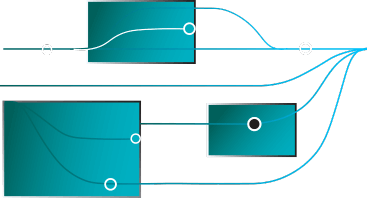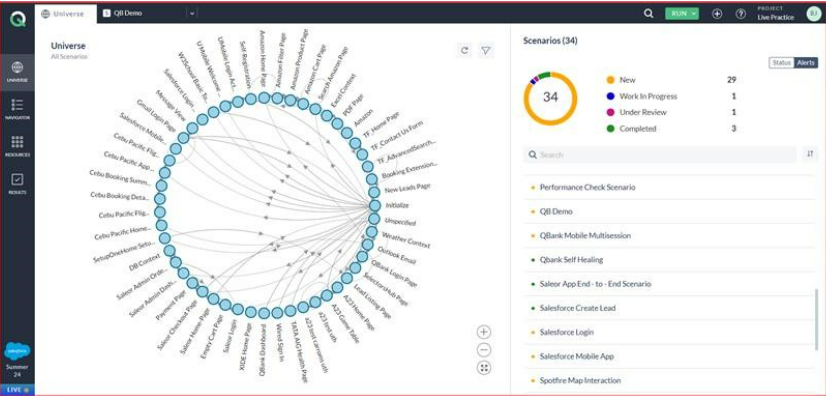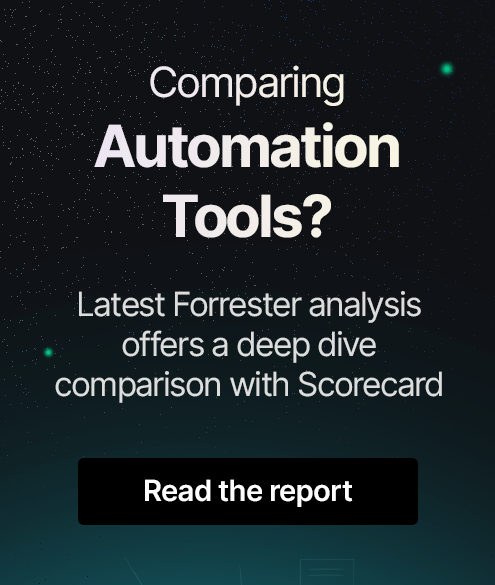Streamline test assets for effective test automation. Use ACCELQ universe.

Test assets are critical components in the software testing process, comprising various resources used to plan, execute, and evaluate tests. They include test plans, test cases, test scripts, test data, test environments, and documentation of the testing approach adopted. Test assets play an important role in adopting a continuous testing strategy as they provide the required structure, data, and tools to execute and manage tests effectively.
Getting started with Test Assets
Test assets are critical components in the software testing process, comprising various resources used to plan, execute, and evaluate tests. They include test plans, test cases, test scripts, test data, test environments, and documentation of the testing approach adopted.
Establishing the best mapping of test assets is at the foundation of continuous testing, contributing to the overall efficiency, effectiveness, and quality of software delivery.
- Structuring test assets in a folder structure helps keep the files separated based on name mapping criteria, tests, scripts, and other necessary files.
- This will allow testers to refer to them quickly and ensure that tests are stable when updates are made.
- Conducting exploratory tests to get an idea of how internal system workflows are configured helps understand how the
- It is necessary to create a system or perform an update.
- Basic name-mapping properties may be created depending on the tool chosen, and scripts for the actions required to identify objects may be written.
- All the above must be noted down so that it helps how the automation assets test them.
Do more with Test Automation
Discover more ways to add ‘low-code no-code‘ test automation in your workflows

Why is streamlining and mapping test assets important?
| 1. Comprehensive Test Coverage | Functional /non-functional testing gaps are addressed, and proper mapping identifies and reduces gaps in coverage by addressing early. |
| 2. Enhances Traceability | Helps with Requirements traceability Matrix (critical to track testing progress), Change management (ensure test cases are up to date), Resource allocation, and prioritization. |
| 3. Improves Test Planning and Management | No more duplicates with optimised test execution. |
| 4. Increases Efficiency/ Reduces Redundancy | No more duplicates with proper mapping and optimises test execution in logical sequence. |
| 5. Facilitates Effective Defect Management | Root cause analysis to check defects and Impact analysis f or accurate outcomes. |
| 6. Supports Test Automation | Automated Test scripts aligned with requirements and easy maintenance of automated test suites. |
| 7. Enhances Communication/Collaboration | Clarity in stakeholder communication as well to developers, testers and analysts. |
| 8. Supports Compliance and Auditing | Better documentation makes it easy for new team members to understand. Clear audit trial. |
| 9. Improves Quality and Reliability | Systematic and consistent quality in testing leading to enhanced productivity and reliability. |
Introducing ACCELQ Application Universe
Understanding ACCELQ Universe:
The "Application Universe" in ACCELQ visualizes a given application under test (AUT). It is a graphical blueprint that maps out the relationship between different test assets within your ACCELQ project. Simply put, it is a visual blueprint of all test assets created in each project. Here's a breakdown of its components and functionalities:
Graphical Blueprint:
- Application Universe is a graphical representation of the application under test (AUT).
- Circles represent some contexts and denote different states or screens within an application.
- Actions are lines connecting the contexts representing actions or transitions between these states.
Components:
Map View:
- Shows the blueprint of the AUT with contexts and actions.
- Clicking on the lines (actions) provides details about the action, such as its name and description.
Sidebar:
- Lists all scenarios in the project.
- Allows filtering scenarios based on status and alerts.
- Clicking a scenario shows its steps and filters the Map View to display them graphically.
Practical Steps to Streamline Test Assets:
- Set Up Your Application Universe
- Define all contexts (states/screens) of your application.
- Map out actions (transitions) between these contexts.
- Organise Scenarios
- List all test scenarios and categorise them based on their status (e.g., pending, in-progress, completed).
- Use alerts to highlight scenarios requiring immediate attention.
- Utilise Filters
- Apply filters to focus on specific test suites or scenarios.
- Regularly review and adjust filters to align with testing priorities.
- Leverage Parallel Testing
- Implement parallel testing to run tests simultaneously across different contexts.
- Monitor test execution and results to ensure comprehensive coverage and quick feedback.
Filtering the Universe:
- Project Assets: Choose to view all assets in the current project or select specific test suites.
- Filter Icon: Clicking the filter icon helps apply filters and customiseF the view according to needs.
By leveraging the features of ACCELQ Universe, the management and execution of test assets can be streamlined, leading to a more efficient and effective testing process.
Conclusion
The Application Universe in ACCELQ enhances the visibility and manageability of the testing process by providing a detailed and interactive visual representation of the application and its testing assets. Streamlining test assets with ACCELQ Universe involves leveraging its features to manage and thus optimise testing efforts effectively. The Application Universe provides a visual, intuitive way to organise, access, and navigate test assets, ensuring a more efficient and cohesive testing workflow.
Contact us to understand how ACCELQ can accelerate your test automation using the power of no-code and AI.
Balbodh Jha
Associate Director Product Engineering
Balbodh is a passionate enthusiast of Test Automation, constantly seeking opportunities to tackle real-world challenges in this field. He possesses an insatiable curiosity for engaging in discussions on testing-related topics and crafting solutions to address them. He has a wealth of experience in establishing Test Centers of Excellence (TCoE) for a diverse range of clients he has collaborated with.
Discover More
 Testing MS Dynamics 365 with ACCELQ
Testing MS Dynamics 365 with ACCELQ
Testing MS Dynamics 365 with ACCELQ
 What is Salesforce Health Cloud? Here Are the Top Benefits
What is Salesforce Health Cloud? Here Are the Top Benefits


































